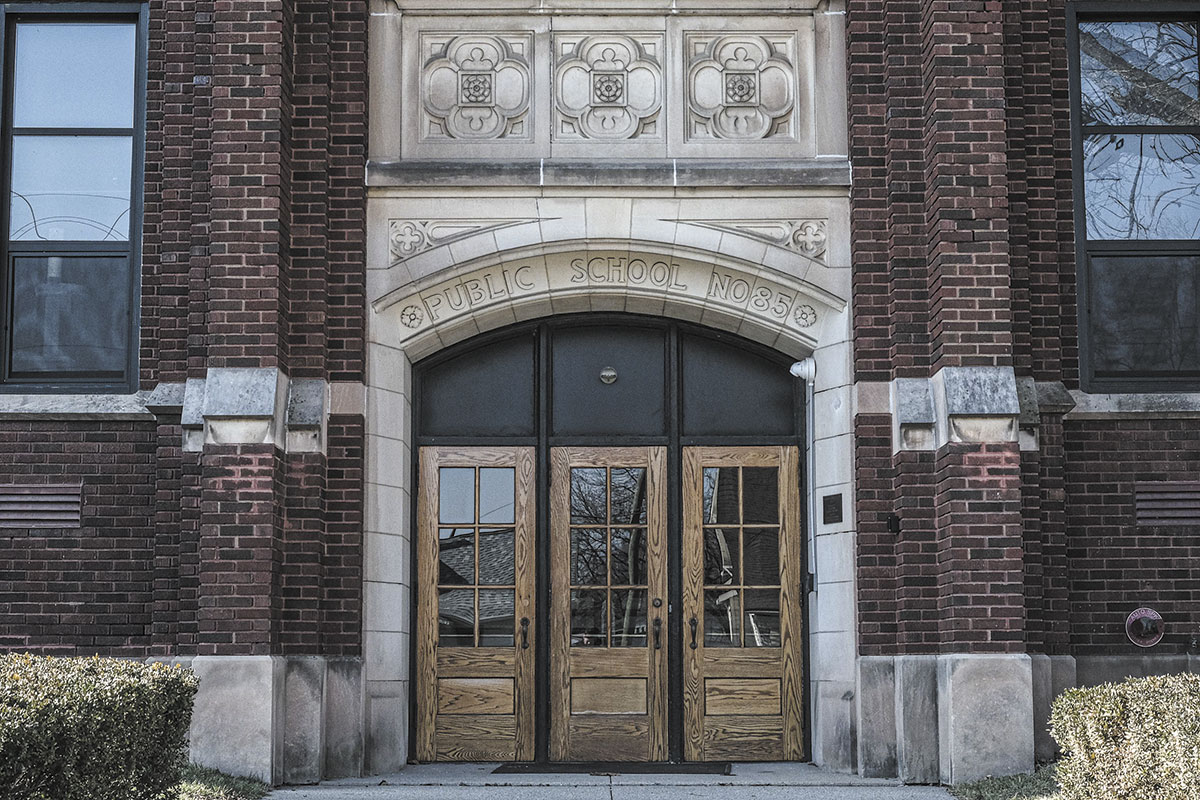Subscriber Benefit
As a subscriber you can listen to articles at work, in the car, or while you work out. Subscribe Now
A group of architects is pushing the Legislature to reestablish Indiana’s historic preservation tax credit for commercial buildings, an effort to create more incentive for developers to rehab vacant, deteriorating institutional structures in communities throughout the state.

The Indiana chapter of the American Institute of Architects has been working with House and Senate lawmakers to build support for proposals contained in House Bill 1399 and Senate Bill 174 that would reestablish the historic preservation tax credit that was eliminated in 2016 and was replaced with a grant program that critics say was too limited.
“Every town in Indiana has got a Main Street. They’ve got an old jail. They’ve got an old school,” said Terry Bradbury, a member of the Indiana chapter of the American Institute of Architects. “I’ve done three or four school conversions to housing with tax credits. They make a world of difference in the community.”
The House bill authored by Republican Rep. Sharon Negele, R-Attica, would award developers income tax credits worth 25% of their rehabilitation costs, or up to 30% if the project is not income producing. That means, for example, that a company that spends $10 million on a project could deduct $2.5 million to $3 million from the taxes it owes in a given year, depending on the project’s details.
The Senate bill authored by Sen. Dan Dernulc, R-Highland, is similar, but it would allow the tax credit to also be applied to financial institutions tax or the insurance premiums tax.

Negele’s bill would cap the total credits claimed per year by all companies at $20 million. The Senate bill has no cap. The nonpartisan Legislative Services Agency estimates that bill could reduce tax revenue by $9.8 million to $59.8 million in the first year.
Either approach would provide far more money for historic preservation than was allowed under Indiana’s old tax credit law, which capped the total credits at $450,000 a year.
It’s an important investment, Negele said. In her own town of Attica, more availability of tax credits could be an incentive for developers to preserve the historic downtown through renovation, she added.
“The reality is that, if you don’t have these kinds of programs, it’s very, very difficult to get developers and people interested in rehabbing,” Negele said. “So this tool is a great catalyst to make that happen.”

Indiana is one of just 13 states without a historic tax credit program for commercial buildings, according to Indiana Landmarks President Marsh Davis. While one was created in 1993, Davis said the annual funding level of $450,000 was “really embarrassing” and made it the smallest program in the country.
Despite the lack of funding, the state continued to award the tax credit, Davis said. That led to a 13-year backlog of recipients, meaning developers could be awarded tax credits for projects under construction in one year but would not be able to actually claim them to lower their tax bills for more than a decade.
In effect, the program was dormant due to the backlog.
Advocates partly blame the demise of the program on retired House Ways and Means Chairman Tim Brown, a Republican from Crawfordsville, who acknowledged in a recent phone interview with IBJ that he is not a fan of the tax credits. But then-Senate Tax Chairman Brandt Hershman, a Buck Creek Republican who led a commission that reviewed the effectiveness of tax credits, said at the time that he didn’t believe the historic tax credit was spurring much development, especially because a federal tax credit is also available for projects.
Under Brown’s and Hershman’s leadership, the Legislature axed the credit in favor of a $700,000-a-year grant program for rehabilitating properties.
Davis said the grant program was helpful, but it didn’t provide the robust incentive that a larger tax credit creates.
Brown and Hershman are now retired from the Legislature, and advocates are hopeful lawmakers will be more open to restoring the tax credit program and boosting its funding.
Negele, who has served on the Indiana Landmarks board and has sat on the House Ways and Means Committee for eight years, has advocated for funding the program. But her past attempts have been dismissed by the Legislature without even a committee hearing.
The Indiana architects group hopes this will be the year that changes.

Jason Shelley, the group’s executive director, said he has seen the transformative environment the renovation of historic properties has brought to his hometown of Madison and believes a tax credit could bring more of that to the entire state.
Madison’s Eagle Cotton Mill, built in 1884, recently was turned into a boutique hotel and conference center. Shelley said the project took longer because funding was hard to secure.
“Somehow they were able to get it done. But it took them years to make that project happen,” he told IBJ.
For Indiana Landmarks, the hope is that the tax credit will encourage developers to save some of the historic buildings on its “10 Most Endangered” list. A tax credit often can be a tipping point in getting a project over the finish line, he said.
Marsh said the credit could be particularly crucial in saving the Hulman Building and Garage in downtown Evansville, a 10-story Art Deco building constructed in 1929.
“It’s just one of the state’s gems. It needs a full rehabilitation, but the developers looking at it can’t quite make the numbers work,” Davis told IBJ. “The state tax credit will help fill that gap.”
The benefits
Advocates say that a historic preservation tax credit can not only help attract developers to historic buildings and districts, it can also encourage cheaper, more sustainable development that could create local jobs. In addition, with the “bones” of a structure already in place, improvements can happen more quickly than with newer builds.

“You’re bringing new life into that area and providing quality housing, in some cases in areas that were once blighted,” said AIA Indiana President Desma Belsaas.
And because restoration projects can require a higher level of craftsmanship and deeper knowledge of the structure, Shelley said, they often spur more local hiring.
At a time when Indiana is hurting for professional workers, Shelley also said the placemaking that comes from preserving unique historic buildings could help bring people into the state.
Davis echoed that the credit could make Indiana more competitive. Developers are currently disincentivized from investing in Indiana historic preservation projects due to the lack of a historic tax credit program, he said.
“Some of the developers that are doing these historic projects are taking their business to other states because they have the state credits,” Davis said. “Indiana, I think, is losing out by not having one.”
A question of funding
It could still be a difficult task to get the Legislature to fund the program at the requested level.
The state is moving into a year with decreased COVID funding, and the Governor’s Public Health Commission is requesting an additional $240 million annually to help fight the state’s low-ranking status in public health. In crafting the next two-year budget, the Legislature will hear from many agencies and causes vying for more funding.
Still, the tax credit’s cost of $10 million to $20 million a year is considerably less than the $150 million a year that states such as Ohio invest in their historic preservation programs.
Negele said her task will be educating her colleagues about the importance of the credit.
“There’s some fabulous programs out there that can be emulated from other states that are working on trying to save some of these historic buildings, and if the incentives are there, it makes sense for them to do it,” Negele said.
She said Attica, which has five historic districts, needs the credit to help maintain its historic buildings.
“It’s just frustrating that, you know, to even entice the developer there to save a building without these credits available to them—it just falls by the wayside and doesn’t happen.”•
Correction: The example of how the tax credit works has been corrected. Originally, the story used an example of a tax deduction, rather than a tax credit. See more corrections here.
Please enable JavaScript to view this content.


To clarify, since nobody asked me, I am a strong supporter of historic building preservation and always have been. The tax credits were so oversubscribed at the time that they were useless, and we thought the creation of a directed program with almost twice the funds would be a good start until we had more money available to appropriate. The federal tax credits are clearly more lucrative, but I supported some type of state program. I think these proposed bills are a good idea.
No.
The author uses an example of a tax deduction, but everything else I’m reading implies that these are tax credits. Someone please explain to Taylor that these are two different things…
Hi Matthew. I’m the editor of IBJ. This was mistake was mine, not Taylor’s. I appreciate that you pointed it out. I do know the difference between a deduction and a credit and have written about both many times. But obviously, I didn’t show that here and added a mistake to Taylor’s story. Again, thank you for pointing it out, and I have corrected it. -Lesley